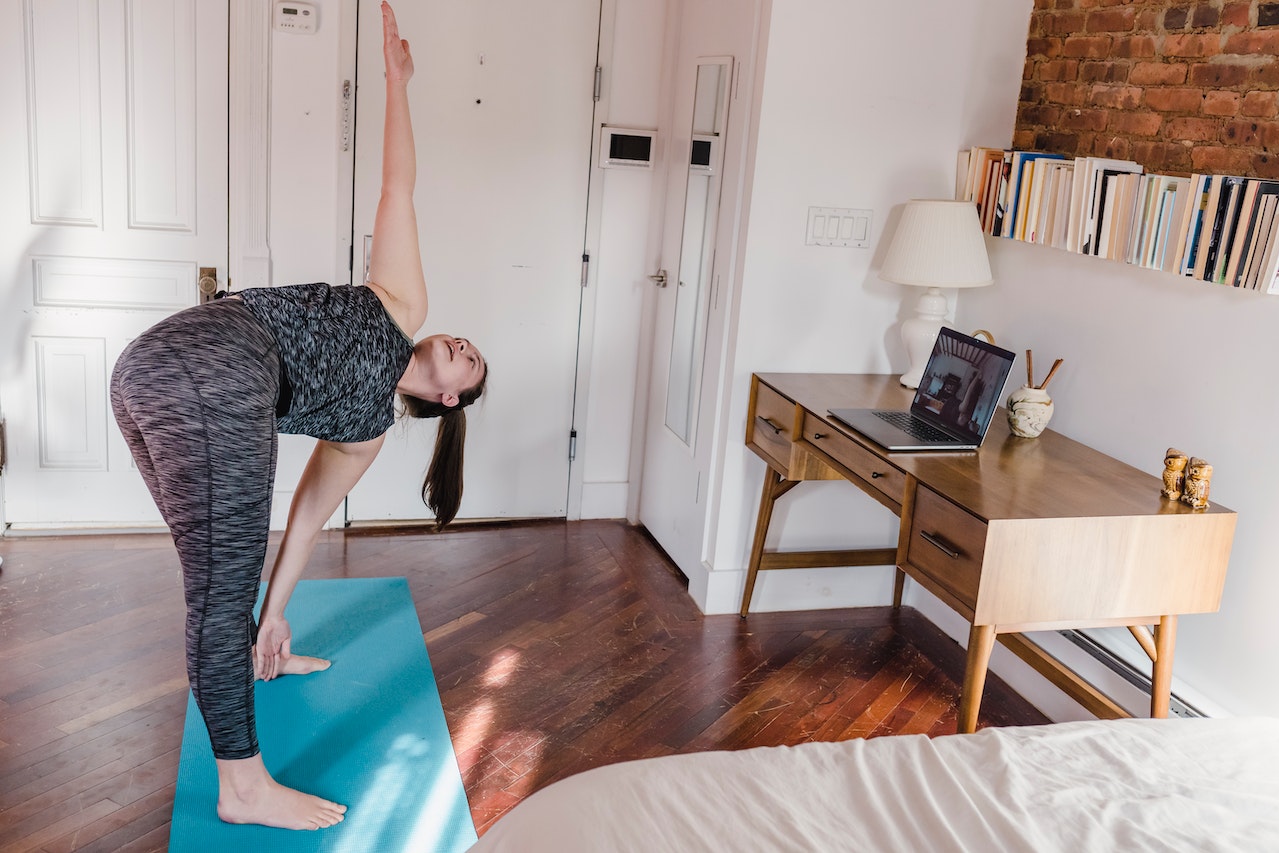online yoga teaching: how to: get started

Are you looking to become a certified yoga instructor? Have you considered teaching your practice online? With expert guidance, it’s never been easier to learn how to teach yoga online.
In this article, we’ll discuss the types of yoga you can teach and the benefits of teaching them online.
But most of all, we’ll give you a helpful guide to getting started teaching online, with everything you need to create an online presence, set up a calming practice space, promote and price your services, develop and write an effective and inclusive curriculum, and grow your client base.
So if you’re ready to explore the world of virtual yoga instruction, read on! Learning how to teach yoga online with expert guidance is within reach—and it could just be the thing that takes your career as an instructor to the next level.
What is yoga exactly?
Yoga is an ancient practice that has been around for centuries. It’s a holistic approach to physical, mental, and spiritual well-being. Yoga combines postures (“asanas”), breathing exercises (“pranayama”), and meditation in one complete system.
On the physical side, it increases strength, flexibility, and balance while calming the nervous system.
On the mental level, it helps to reduce stress and anxiety, improve concentration and cultivate self-awareness. On the spiritual level, yoga cultivates a sense of connection to something greater than oneself.
The beauty of yoga lies in its ability to be adapted to any person or body type. There are techniques suitable for everyone from young children to seniors, people with disabilities or chronic conditions, as well as athletes looking for an edge in their performance.
With regular practice, yoga can help you achieve optimal health and well-being both physically and mentally.
No matter your age or lifestyle, there is something about yoga that can benefit you in many ways. It is an excellent way to take care of yourself in our increasingly fast-paced world – so why not give it a try?
Types of Yoga
Now that you have a better understanding of yoga, it’s time to explore the different types. There are many styles of yoga, but generally, they can be categorized into four main groups: Hatha, Vinyasa, Power, and Restorative.
Hatha is one of the most popular and well-known forms of yoga. It consists of basic poses and postures that are held for longer periods. Hatha also includes breathing exercises known as pranayama. This style is great for beginners because it emphasizes slow movements and simple poses.
Vinyasa is another type of yoga that has become increasingly popular in recent years. Vinyasa focuses on linking breath with movement through a series of poses that flow together in a continuous sequence. This style is challenging and invigorating, as it involves more dynamic movements than Hatha does.
Power yoga is an intense form of yoga that combines strength training with traditional yoga postures. Power yoga classes usually involve a fast-paced sequence with lots of sun salutations and challenging transitions between poses. It’s a great way to build strength and flexibility while getting your heart rate up at the same time.
Restorative yoga is a gentle practice that helps to relax both mind and body by holding postures for extended periods using props such as blocks or bolsters to support the body in each pose.
Restorative classes are perfect for anyone looking to reduce stress levels or recover from an injury or illness as they focus on calming rather than energizing the body.
Yoga provides something unique for everyone – no matter your fitness level or preference, there’s sure to be a style that suits you perfectly! With so many different types available, the possibilities are endless when it comes to exploring the world of yoga!
Also Read >>> 200-hour yoga teacher training: online and comprehensive
Benefits Of Teaching Yoga Online
Teaching yoga online has many advantages. For example, you don’t have to worry about finding a space to teach or having enough students for a class. You can teach from the comfort of your own home, and there are no travel costs or time commitments associated with teaching online.
It also allows you to reach more people across different geographic locations than if you were teaching in-person classes.
Not only is teaching online convenient and cost-effective, but it also gives you access to expert guidance. With online courses and tutorials, you can learn how to properly perform different poses and sequences.
This helps ensure that your students are receiving quality instruction while protecting their safety during practice. You’ll be able to confidently lead classes that challenge and inspire your students without worrying about making any serious mistakes.
Online teaching also provides an opportunity for personal growth as a yoga instructor. You’ll be able to explore your creativity, refine your skillset, and become more knowledgeable while connecting with like-minded people around the world.
Through this journey of self-development, you’ll be able to create an impactful career in yoga that brings joy and fulfillment into your life!

Preparing To Teach Online
Teaching yoga online requires more preparation than an in-person class. It’s important to set yourself up for success before you start teaching. First, make sure your technology is working and that your internet connection is reliable.
You’ll need a camera and microphone of good quality and a platform like Zoom or Google Hangouts that allows you to record classes and share them with students.
The next step is to create a clear plan for your classes. Think about the duration, frequency, and format of the class, as well as the content you want to cover. Make sure your lesson plans are comprehensive but also flexible enough to accommodate changes or requests from students.
Finally, it’s important to have clear guidelines for students regarding things like attendance, payment, and expectations from them during class. Having a written policy can help ensure everyone is on the same page when it comes to expectations for the course.
Putting in this extra effort will pay off when it comes time to teach online. With these preparations in place, you can focus on delivering an engaging and fulfilling experience for your students without worrying about technical issues or other distractions.
Creating An Online Presence
Creating an online presence is essential for those wishing to teach yoga online. It’s important to understand the basics of web design and how to create a website or blog that will showcase your skills as a yoga teacher.
This can include information about your background, qualifications, and teaching style. You should also include pictures or videos of your classes as well as contact details so potential students can reach out to you.
Once your website or blog is up and running, it’s time to start building a social media presence. Social media can be an effective tool for engaging with potential students and promoting your classes.
You should post regularly on platforms such as Instagram, Facebook, Twitter, YouTube, and LinkedIn. Share useful content related to yoga such as tips, stories, and advice from fellow teachers and industry professionals. Make sure to respond promptly to any questions or inquiries from followers.
Finally, consider investing in digital marketing strategies such as email campaigns and paid advertising. These strategies can help you reach more people and increase the visibility of your business.
Many digital marketing platforms offer low-cost solutions that are easy to use even if you don’t have a lot of experience with them. With the right guidance and effort, you can create an effective online presence quickly and affordably.
Understanding The Technology Behind Teaching Yoga Online
Technology plays an important role in teaching yoga online, and is having an increasingly important impact on the yoga world. It allows instructors to reach a wider audience and share their knowledge with people from all over the world.
But it can also be confusing and frustrating if you don’t know where to start. That’s why it’s important to understand the basics of how technology works for teaching yoga online before you get started.
First, you’ll need to choose a platform that fits your needs. There are many options available, so take some time to think about what you want out of your online classes and pick one that meets those requirements.
You’ll also need to figure out what kind of equipment you’ll need, such as a camera, microphone, laptop or tablet, and video editing software. Once you have these pieces in place, you can start thinking about other aspects of teaching yoga online, like pricing models and content delivery methods.
Once everything is set up and ready to go, you’ll have access to tools like marketing analytics, live streaming capabilities, and integrations with other services.
These features will help you build your business and keep track of your progress as an instructor. With the right guidance and support from experts in the field, setting up technology for teaching yoga online can be straightforward and enjoyable.
Setting Up Your Home Studio
Setting up your home studio is an important step to teaching yoga online. It’s important to create a space that has good lighting, soundproofing, and ergonomics. Here are some tips to help you get started.
First, choose a space with adequate lighting and plenty of natural light if possible. Make sure the room has enough room for you and your students to move around comfortably. Additionally, it should be free of clutter, so that it doesn’t distract from the practice or impede movement.
Next, consider soundproofing the room if you have noisy neighbors or live in an apartment complex. Invest in foam padding to cover walls and floors and purchase heavy curtains for windows.
This will ensure your classes are not interrupted by outside noise. Finally, ensure that the furniture is comfortable and ergonomic for both yourself and your students. Invest in adjustable chairs if needed, as well as cushioned mats for extra comfort during class. With these tips in mind, you should be able to create an ideal home yoga studio!
Developing A Curriculum
Developing a curriculum for teaching yoga online is essential. It’s important to plan out exactly what you intend to cover in each class, and also make sure you have enough material to last the entire session.
You’ll need to think about how long your classes should be, what topics you want to cover, and how to present the material for it to be easy for students to follow along.
When creating a curriculum, it’s important to consider the needs of your students. What do they expect from an online yoga teacher training class?
Decide on topics that are suitable for all levels of experience so that everyone can benefit from the lesson. Additionally, carefully consider pacing and sequencing; transitioning between poses is key when trying to create a well-rounded flow.
Incorporating props into a yoga session is also beneficial and can help teach proper alignment and relaxation techniques.
Props such as blocks, straps, bolsters, or blankets can help make certain poses more accessible. Incorporating these items into your practice will give your students extra support during their sessions and ensure they reap all of the benefits of each pose.
By crafting an effective curriculum that fulfills the needs of your students and addresses their level of experience with yoga, you can ensure that their experience learning yoga online is both informative and enjoyable.
Writing Effective Instructional Content
Creating an effective online yoga lesson takes more than just knowing the poses. It requires knowledge of instructional design principles and an understanding of how to present the material in a way that engages students. To write engaging instructional content, there are a few tips to consider.
First, be sure to break down your lesson into manageable, logical chunks. Each step should be clearly defined and easy for the student to follow along with. Avoid long-winded explanations and use visuals or diagrams where appropriate. As much as possible, try to keep your instructions concise but comprehensive.
It is also important to provide context for each pose or sequence you teach. Explain why each pose is beneficial and how it relates to the previous one.
This helps students understand not only what they are doing, but why they are doing it. Be sure to include modifications so that everyone can participate in the lesson regardless of their ability level or experience with yoga.
In addition to providing instructions for each pose, add in some other elements such as breathing exercises or meditation techniques that can help enhance the student’s practice overall.
Your goal should be to give them more than just physical postures; every lesson should have an educational component as well as a spiritual element that will make it truly unique and memorable for them.
With thoughtful planning and execution, you can create engaging and meaningful online yoga lessons that your students will enjoy learning from!
Customizing Your Classes For Different Audiences
Teaching yoga online requires you to tailor your classes for different audiences. You’ll need to be able to understand the needs and goals of each student, as well as the overall class. With this in mind, it’s important to create a personalized plan for each student and determine how best to modify the exercises for their particular needs.
For instance, if you’re teaching a beginner class, you’ll want to provide a slower pace and simpler poses that are easier for beginners to follow. Additionally, you may want to include more instruction on proper alignment and breathing techniques.
On the other hand, if you’re teaching an advanced class, you can focus more on challenging poses and sequencing. You can also offer more opportunities for self-exploration by giving students time to experiment with different variations of poses.
By customizing your classes according to each of your class’ needs, you can help ensure that everyone is getting the most out of their practice. This will help foster an enjoyable environment that encourages learning and growth so that students can reach their yoga goals.
Pricing And Packaging Your Services
Now that you have a better understanding of how to customize your classes for different audiences, it’s time to discuss pricing and packaging your services. As a yoga instructor, you need to decide on the best way to price and package your online classes.
There are a few key factors to consider when determining the prices for your services. First, consider the duration and difficulty of your classes.
For instance, if you offer longer classes that require more preparation and effort from yourself, then you should charge more than shorter classes that require less preparation. Additionally, look at the cost of similar services offered by other yoga instructors to get an idea of what is fair market value for your services.
Finally, think about how you want to package your services for sale. For example, offering packages with multiple class sessions or discounts for bulk purchases can be a great way to attract customers and increase sales.
You can also offer special promotions or giveaways as incentives for signing up for your service. Be sure to track the success of each marketing strategy so that you can adjust them accordingly to maximize profits and keep customers happy.
Using Social Media To Promote Your Classes
The popularity of social media has made it a great tool for promoting your yoga classes. It’s a cost-effective way to reach potential students and build an audience of followers. With a few simple steps, you can create a social media presence that will help get the word out about your classes.
First, choose the platform that best suits your needs. Facebook and Instagram are popular options, but there are many other platforms available.
Consider which one is most likely to reach your target audience, then decide how often you want to post content. You should also consider creating an email list so that people can sign up to receive updates about your classes.
Once you’ve got the basics down, it’s time to start crafting engaging posts. Use attractive visuals and inspiring stories to engage people in conversations about yoga and create interest in what you’re offering.
You should also be sure to respond quickly to any comments or questions that come up in your posts. By keeping your followers engaged, they’ll be more likely to attend future classes or recommend them to their friends.
Strategies For Growing Your Client Base
To grow your client base when teaching yoga online, it’s important to use various strategies. First of all, you should create a website for yourself and use it to promote your classes.
It’s best to keep the design simple and user-friendly so that potential clients can easily find out more about you, your classes, and how to get in touch with you. You should also use social media platforms such as Facebook and Instagram to share content about your classes and attract new students.
You should also consider offering discounts or promotions on an occasional basis so that people are encouraged to join your classes.
This is especially beneficial if you offer group classes since it will help fill up the spots faster. Additionally, make sure to respond promptly to inquiries from potential clients so they get the impression that you’re professional and reliable.
By following these strategies, it’s possible to steadily grow your client base over time. To ensure success, be consistent in your approach and always strive for excellence in terms of both customer service and the quality of yoga instruction provided.
Professional Development Opportunities
Learning to teach yoga online can open up a world of professional development opportunities. Whether you’re just starting or have been teaching yoga for years, taking an online course can help enhance your skills and knowledge. With access to expert guidance, you can learn advanced techniques and strategies to improve the quality of your classes.
Online courses are designed to give you the flexibility to learn at your own pace and schedule. You’ll be able to access all the materials in one place, so you won’t have to worry about missing important information or going back over the material multiple times.
Most courses also include videos and audio recordings from instructors, so you can watch them as many times as you need.
Professional development is an essential part of any yoga practice, and learning to teach yoga online gives you the chance to take advantage of this type of learning without having to leave home.
With expert guidance at your fingertips, you can become a better teacher faster – whatever your level of experience may be.
Working With Expert Guidance
Working with expert guidance when learning to teach yoga online is an invaluable asset. It can provide insight and clarity into the path ahead, as well as provide comfort, support, and guidance.
Professional trainers and teachers can help you understand the fundamentals of teaching yoga, as well as help you develop your unique teaching style.
When working with an expert, it’s important to find a teacher who fits your needs and who understands your goals. You should look for somebody knowledgeable and experienced in teaching yoga, who has excellent communication skills and is willing to work with you on a long-term basis. A good teacher will be able to provide you with helpful tips and advice on how to become a successful yoga teacher.
Finding the right teacher or trainer is essential if you want to learn to teach yoga online successfully. With their help, you’ll be able to gain valuable knowledge and experience that will help you on your journey toward becoming a successful yoga instructor. Ultimately, doing this will give you the confidence and skill set required for success in this field.
Conclusion
As a yoga teacher, it’s important to remember that you don’t have to do it all alone. Working with expert guidance can help you build the skills and confidence necessary to teach yoga online successfully.
With the right strategies and resources, you can create a successful online teaching business that will bring you joy and satisfaction as well as financial rewards.
No matter where your journey takes you, make sure that you’re always learning and growing as a teacher.
Take advantage of professional development opportunities when they arise, seek out feedback from experienced colleagues, and stay connected with the larger yoga community so that you can continue to share your knowledge and expertise with others.
With the right guidance and support, teaching yoga online can be an incredibly rewarding experience. It takes time, effort, and dedication to become a successful yoga teacher – but it’s worth it in the end!



